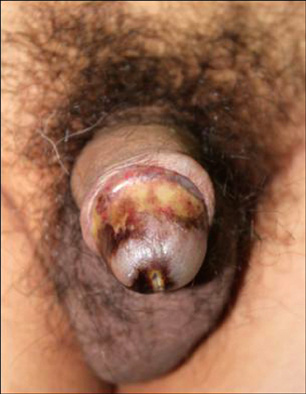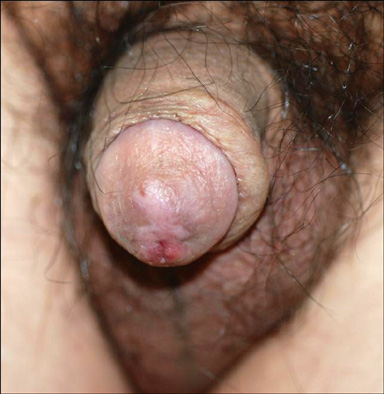Ann Dermatol.
2011 Dec;23(Suppl 3):S306-S309. 10.5021/ad.2011.23.S3.S306.
Complications Following BellaGen(TM) Injection
- Affiliations
-
- 1Department of Dermatology, College of Medicine, Chung-Ang University, Seoul, Korea. drseo@hanafos.com
- KMID: 2171858
- DOI: http://doi.org/10.5021/ad.2011.23.S3.S306
Abstract
- BellaGen(TM) is an injectable acellular dermal matrix granule derived from donated human skin tissue that was recently developed for soft tissue augmentation. Its use has been sporadically reported in penile girth enhancement procedures. Many cases of complications have been reported after injecting acellular dermal matrices like AlloDerm or SureDerm(TM) but few reports on complications associated with BellaGen(TM) injection. We report here on penile skin inflammation and necrosis following augmentation phalloplasty with BellaGen(TM), which developed 3 days after the injection and persisted for more than 2 weeks. The patient had a 15 year history of type 2 diabetes mellitus, and he was treated with oral antibiotics and wet dressings with KMNO4 solution to combine preservation of the remaining penile soft tissue with debridement of avascular tissue. The lesion improved with this treatment, but the patient experienced pain for about 2 weeks. All patients should be informed of the potential complications with the use of injectable acellular dermal matrices before treatment. Patient selection for augmentation is also important to have the most desirable results.
Keyword
MeSH Terms
Figure
Reference
-
1. Alter GJ. Ehrlich RM, Alter GJ, editors. Aesthetic surgery of the male genitalia. Reconstructive and plastic surgery of the external genitalia: adult and pediatric. 1996. Philadelphia: Saunders;460–470.
Article2. Wessells H, Lue TF, McAninch JW. Penile length in the flaccid and erect states: guidelines for penile augmentation. J Urol. 1996. 156:995–997.
Article3. Vardi Y, Har-Shai Y, Gil T, Gruenwald I. A critical analysis of penile enhancement procedures for patients with normal penile size: surgical techniques, success, and complications. Eur Urol. 2008. 54:1042–1050.
Article4. Whitehead ED. Allograft dermal matrix graft (Alloderm®) for pericavernosal penile widening in normal men. Abstract presented at: First World Congress on Aesthetic Medicine. March 15-17, 2004; Rio de Janeiro, Brazil.5. Lanier ST, Wang ED, Chen JJ, Arora BP, Katz SM, Gelfand MA, et al. The effect of acellular dermal matrix use on complication rates in tissue expander/implant breast reconstruction. Ann Plast Surg. 2010. 64:674–678.
Article6. Namnoum JD. Expander/implant reconstruction with AlloDerm: recent experience. Plast Reconstr Surg. 2009. 124:387–394.
Article7. Taylor JB, Gerlach RC, Herold RW, Bisch FC, Dixon DR. A modified tensionless gingival grafting technique using acellular dermal matrix. Int J Periodontics Restorative Dent. 2010. 30:513–521.8. Zhang JM, Cui YY, Pan SJ, Liang WQ, Chen XX. Penile augmentation using acellular dermal matrix. Zhonghua Zheng Xing Wai Ke Za Zhi. 2004. 20:418–420.9. Hinman F Jr. The blood supply to preputial island flaps. J Urol. 1991. 145:1232–1235.
Article10. Bruno JJ 2nd, Senderoff DM, Fracchia JA, Armenakas NA. Reconstruction of penile wounds following complications of AlloDerm-based augmentation phalloplasty. Plast Reconstr Surg. 2007. 119:1e–4e.
Article11. Micheels P. Human anti-hyaluronic acid antibodies: is it possible? Dermatol Surg. 2001. 27:185–191.
Article
- Full Text Links
- Actions
-
Cited
- CITED
-
- Close
- Share
- Similar articles
-
- Penile Erection Induced by TM Sterile Powder in Dogs: Comparison with Bimix, Papaverine, and Prostaglndin E1
- The Function of Memory CD8+ T Cells in Immunotherapy for Human Diseases
- Randomized Trial Comparing a Starion(TM) and a Harmonic Scalpel(TM) Hemorrhoidectomy
- Comparison Study of Reticulocyte Enumeration by H*3 RTX(TM), FACScan(TM), and Manual Counting
- Comparison of Scarclinic-thin(TM) and Scarclinic(TM) in Terms of Scar Improvement: A pilot study




